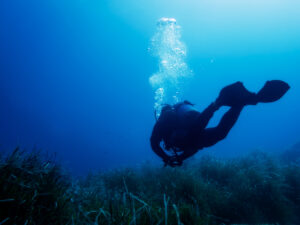What is Rigid Inflatable Boat (RIB) for Scuba Diving?
Rigid Inflatable Boats (RIBs) are specialized, high-performance crafts that have gained significant popularity in the scuba diving community over the last few decades. The fusion of an inflatable collar with a rigid hull gives these boats an edge in terms of speed, stability, and safety, making them an excellent choice for diving expeditions.
Construction and Design
RIBs combine the best elements of traditional inflatable boats and hard-hulled boats. The “rigid” part of the RIB comes from the hard hull, typically crafted from fiberglass or aluminum. This rigid hull provides a stable and solid platform for divers, crew, and equipment.
The “inflatable” part refers to the large buoyant tubes or ‘sponsons’ that run around the boat’s sides. These are usually made from durable and resistant materials such as Hypalon or PVC. The air-filled tubes provide exceptional buoyancy and stability, even in rough sea conditions, while also acting as an effective fender if the boat comes into contact with other vessels, rocks, or coral reefs.
Advantages for Diving
Speed and Maneuverability
Due to their lightweight design and buoyancy, RIBs are highly maneuverable and can reach impressive speeds, making them ideal for quickly reaching dive sites. Their design also allows for shallow draft operation, allowing access to areas that larger boats can’t reach.
Safety and Stability
The air-filled sponsons ensure that the boat remains stable and upright, even in choppy waters. This stability is crucial for divers preparing to enter or exit the water, reducing the risk of accidents.
Capacity and Comfort
RIBs come in various sizes, accommodating a wide range of passenger capacities. The rigid hull offers ample space for divers, gear, and additional equipment, while the inflatable collar provides a cushioning effect, offering a smoother ride compared to other types of boats.
Maintenance and Lifespan
The lifespan of a RIB is generally long, thanks to its sturdy and resilient design. However, it requires proper care and maintenance. The rigid hull can be cleaned and maintained similarly to a standard boat hull, while the inflatable collar requires regular inspections for leaks or damage. It’s also important to monitor and maintain the correct air pressure in the inflatable tubes.
Environmental Impact
A crucial aspect to consider in the context of scuba diving and its reliance on watercraft is the environmental impact. Fortunately, RIBs are relatively environmentally friendly compared to larger, more traditional dive boats. Their lightweight nature means they require smaller engines and thus consume less fuel, reducing their carbon footprint. Furthermore, their design allows for minimal water displacement, reducing potential damage to sensitive marine ecosystems.
Safety Precautions
While RIBs are renowned for their safety and stability, it’s vital to observe standard safety protocols. Divers should remain seated and hold on to the boat’s grab lines when underway, especially in rough conditions. Overloading should be avoided as it may affect the boat’s stability and performance. Regular checks for hull and sponson integrity, along with routine equipment inspections, are essential to ensure the safe operation of a RIB.
Use in Other Water Activities
RIBs’ versatility extends beyond the realm of scuba diving. Their speed and maneuverability make them popular choices for search and rescue operations, patrol duties, and even military applications. In addition, their ability to handle various water conditions has made them a favorite for water sports, such as water skiing and wakeboarding. This versatility adds to their appeal and demonstrates the vast potential of these unique watercraft.
Choosing the Right RIB
When selecting a RIB for scuba diving, it’s essential to consider factors like size, material, and design. The right choice depends on the number of divers and amount of equipment to be transported, typical water conditions in the area, and personal preferences for handling and performance. Consulting with professionals or experienced RIB users can provide valuable insights and guidance in making this decision.
Key Takeaways
In conclusion, Rigid Inflatable Boats provide a remarkable blend of features that make them an outstanding choice for scuba diving operations. From their lightweight design and high-speed capabilities to their stability and safety, RIBs continue to solidify their position as an invaluable asset in the world of underwater exploration. Whether used for recreational diving, marine research, or rescue operations, RIBs have proven to be a reliable and versatile vessel, offering both performance and environmental benefits. As with any watercraft, correct usage, maintenance, and respect for the marine environment are crucial for maximizing the benefits that RIBs offer.
A RIB’s unique combination of speed, stability, and safety has made it an increasingly popular choice for scuba diving expeditions. Whether you’re a dive center operator, a professional diver, or a recreational enthusiast, a Rigid Inflatable Boat could be a valuable addition to your diving toolkit. Its design allows it to offer the best of both worlds—combining the convenience and mobility of an inflatable boat with the stability and performance of a hard-hulled boat—making it an exceptional vessel for any underwater exploration.

















